They arose relatively recently: they were preceded by a long history of bandages made of woven materials, thin and thick, in the form of a diaper or a long narrow strip, then knitted bandages appeared, which created a more comfortable feeling for patients and made it possible to regulate the pressure of the bandage on the diseased area. All this is done by the science of desmurgy - the art of applying bandages.
Finally, you will notice that the patella is not wrapped during this process. In patients with knee pain, the patella is usually already more irritated than Republicans with Obama. The last thing we want to do is squeeze it and irritate it even more. You can still get rid of the swelling in your knee by wrapping it around it.
Elastic bandages are commonly used to treat various musculoskeletal conditions, including osteoarthritis of the knee. To date, there is little evidence to support this practice. Theoretically, however, the brace could improve proprioception of the knee through additional sensory input to the skin, which in turn could improve sensation and thereby lead to improved coordination.
Elastic bandages are enough complex product, designed for repeated use. Using various technologies, an elastic thread, such as latex, is wrapped with a single or double layer of cotton or synthetic thread. And from these “threads” the bandage itself is woven.
However, before you buy or wrap an elastic bandage, carefully study its packaging: elastic bandages, in addition to length and width, have different degrees of elongation - low, medium and high. These elastic bandages are used in various situations:
Others found that the patch was helpful in both groups. However, this benefit is not observed in patients with localized internal disorders such as medial meniscus lesions. Proprioceptive information is derived from at least three sources: joint mechanoreceptors, muscle spindles, and cutaneous touch and pressure receptors. There are many types of skin receptors, but mechanoreceptors are the most important for joint positioning because they respond to movement and touch.
Some are particularly sensitive to the movement of light objects on the skin, while others are stimulated by very rapid movement; Such receptors are spatially specific and quickly adapt. Slower adaptation receptors are important for detecting continuous states of deformation in joint capsules and responding to the degree of suture rotation. Thus, the sensory system accounts for the positional distortion of the mechanoreceptors both within and around the joint. Proprioception initiates reflexes that help stabilize the limb and protect it from excessive movement through the proprioceptive stretch reflex.
Low Tensile Bandages(extensibility of at least 30%) are used to treat complicated forms of chronic venous insufficiency and deep vein thrombosis; provide quick application of dressings when providing the first medical care; provide convenient and reliable fixation of dressings on affected areas of the body.
Medium stretch bandages(extensibility of at least 100%) are used for the treatment of varicose veins, diseases with trophic complications, and for the treatment of postphlebitis syndromes. Recommended for maintaining soft tissues after plaster removal and compression sclerotherapy.
Subsequent reduced sensory input may impair normal movement knee and impair postural and defensive reflexes. The rationale for using an elastic bandage around the knee is to maximize the cutaneous contribution to joint sensation through cutaneous sensation from the area around the knee. However, it is unclear whether proprioception improves with any improvement in function, such as balance. However, increasing mechanical strengthening of the plantar surface of the foot improves postural stability in older adults, suggesting that such functional improvement can occur.
High tensile bandages(extensibility of at least 150%) are used for the treatment of varicose veins of I and II degrees, for the treatment of lipodermic diseases; used in the postoperative period for lymphedema, to maintain joints at rest after injuries and operations; recommended for bandaging bedridden patients.
Whether there is an optimal pressure or density at which the bandage affects proprioception has not been studied. The study was approved by the local research ethics committee. No patient had symptoms, signs, or X-ray findings suggesting coexisting inflammatory or other musculoskeletal diseases, and no patient had a history of syncope, dizziness, diabetes mellitus, parkinsonism, or other conditions that may impair balance. For study participants, patients were required to have current pain in at least one knee, measuring at least 2 cm on a 10 cm visual analog scale for use, rest, or night pain, where 0 cm = no pain and 10 cm = worst pain .

The question: “how to wrap an elastic bandage” can be answered very simply - just like a regular bandage. Those. dressing elastic bandage should follow the schemes developed for dressings with a regular bandage.
Of course, there is a difference, it consists in the huge advantage of an elastic bandage - by creating additional continuous pressure (compression) perpendicular to its surface, it leaves soft tissues and joints the opportunity to move and function within certain limits.
Static positional stability was assessed using a balance performance monitor. The machine is designed to assess the severity of the patient's body. It consists of a feedback unit connected to two base plates. Subjects were asked to stand on their feet with their boots on, with the position of the plates adjusted to that of their normal position, with their arms at their sides and eyes closed. The procedure was performed twice - the first time to acclimatize the subject and the second time for measurement.
Data were acquired at 10 Hz for 30 seconds and presented numerically and graphically. The balance coefficient represents the value of the average weight shifts during a 30-second testing period in the left or right or lateral direction. The influence coefficient is the standard deviation of the balance coefficient. Larger balance and influence coefficients indicate greater amounts of postural instability.
This quality of the elastic bandage allows it to be used both for securing bandages and for treating injuries to the musculoskeletal system and diseases of the vascular and lymphatic systems.
How to properly wrap an elastic bandage
Before using an elastic bandage, let's consider the basic dressing schemes and the goals they serve.
Proprioceptive acuity was assessed by the subject's ability to reproduce passive leg positioning using a specially designed apparatus. The basic design was based on published descriptions. The apparatus consisted of a chair equipped with a device that allowed passive positioning of the "Leg" object, a protractor with single-digit divisions attached to the side of the chair, and a counterweight to the subject's weight to ensure that the leg was weightless during movement. 90° knee flexion corresponded to 90°, and full leg extension to 180° on the protractor.
We hold the edge of the bandage with our left hand, and with our right hand we make several rounds at the same level - as a rule, this is how they begin to apply an elastic bandage.
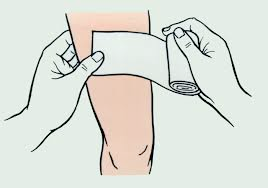
Spiral bandage - ascending and descending.
With an upward spiral, an elastic bandage is applied from bottom to top.
Subjects sat in a chair with their hips and knees in 90° flexion. The leg was moved passively and placed in a specific predetermined position and held there for five seconds. The leg was then returned passively by the examiner to its original position, and the subject was asked to reproduce the criterion. Criterion angles were randomly selected between 90° flexion and full extension. The difference between the criterion and the reproduced angle was taken as a measure of proprioceptive acuity. The procedure was performed with eyes closed and hands folded across the chest.
With a downward spiral, you need to apply an elastic bandage from top to bottom:
This is how they bandage the lower leg, hand or chest. Each subsequent round overlaps the previous one by about 1/3
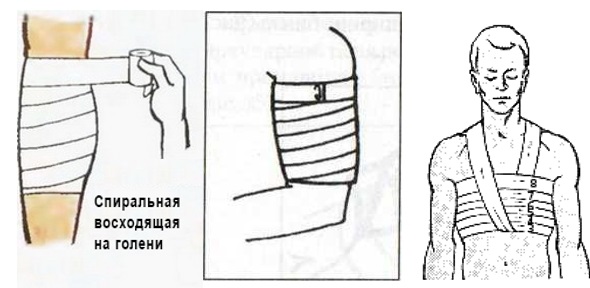
Very often we have to solve the following problem: how to tie an elastic bandage around the entire leg or chest. In general, around a large surface.
Using an elastic bandage
The procedure was performed four times. The first exercise was a test to familiarize the subject with the procedure. The average of the last three studies was considered as proprioceptive acuity for that leg. A randomly assigned size of elastic bandage was applied to both knees. The standard dressing was applied as recommended so that the applied pressure was not uncomfortable or placed pressure on the patellofemoral joint. This way it was supported without slipping or causing noticeable pressure, as might be the case with a patellar inscription.
To do this, you need to apply the bandage in two layers. In the first, we use a method similar to a spiral, but we do not overlap the previous round, but move away from it at a certain distance equal to the width of the bandage. And already in reverse side bandage or spiral, or any other method recommended by a doctor.
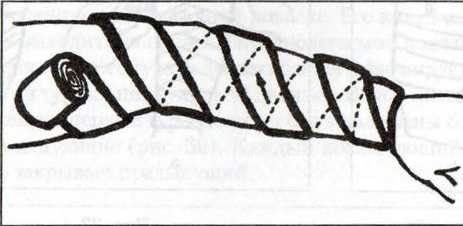
The bandage was cut without a window for the patella so that it would extend from items in the middle of the thigh to their mid-calf, thus replicating the general use. The bandage was applied to both knees, and subjects were allowed to engage in normal physiological activity for 20 minutes. Postural influence, proprioception, and self-reported knee pain were then reassessed in a similar manner as above. The patch was then removed, and assessments of postural influence and proprioception were immediately repeated.
A second set of assessments was performed two weeks later, identical to those of the first visit, except that a second bandage size was applied. Median and interquartile ranges were presented. Their middle age was 1 year old, average height - 65 m, average weight - 8 kg.
The creeping bandage is perfect for the arms (shoulder and forearm) and for the conical areas of the leg - thigh and lower leg. More complex techniques are used for bandaging joints: knee and ankle.
How to apply an elastic bandage to an ankle The most common is a cruciform (figure of eight) bandage for the ankle joint.
Effect of a knee brace on knee pain
The mean of the percentage change between assessment periods for each variable. To compare each pair of variables, either the paired student test or the Wilcoxon signed rank test is used. Anthropometric and descriptive data on pain, postural influence, and proprioceptive acuity for two types of bandages.
Effect of the bandage on proprioception
None of these differences were significant. Proprioception assessed pre-application after 20 minutes of bandage application and immediately after bandage removal for both types of bandages.
Effect of a bandage on static postural influence
Postural lateral impact with bandage pre-application after 20 minutes of bandage application and bandage removal for both types of bandages.The illustrations below show how to correctly apply an elastic bandage to the ankle joint:
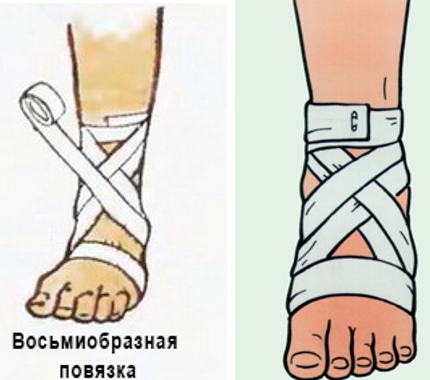
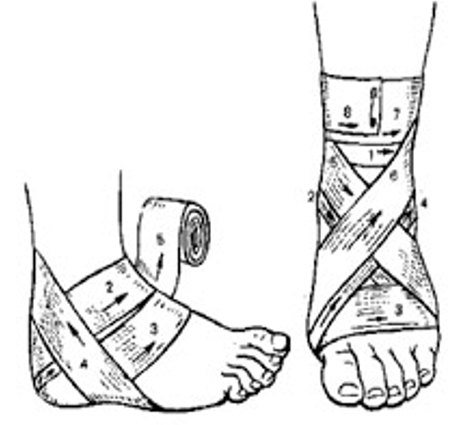
Such a bandage will be appropriate for almost all injuries of the ankle joint.
How to apply it?
However, when the bandage was removed, the fluctuation increased by 62% to a level that was 96% worse but not significantly different from baseline. From this study, it appears that wearing an elastic bandage can influence knee pain, proprioceptive acuity, and postural influence. However, although both bandages reduced knee pain, only the minor bandage showed significant benefit. Both proprioceptive acuity and postural influence improved with the loosened cast, but this benefit was lost with removal.
The standard bandage did not affect postural sway and exhibited a small, nonsignificant decrease in proprioceptive acuity with use. They improved postural influence by placing a raised edge under the boundaries of the plantar surface of the foot to ease the feel of the skin from the sole. However, our finding that the effect of the bandage on knee proprioceptive acuity is not significant, contrary to most studies. This discrepancy may be caused by differences in patient characteristics, assessment method, or applied dressing.
1) We make several turns of the bandage around the shin itself (secure it)
2) Move along the outside of the ankle under the instep
3) Wrap it around the ankle and bring it out again
4) Fasten around the shin
With such a bandage, the ankle joint retains mobility, and this is very important for maintaining the ability of an injured person to work. This type of bandage does not slip or create painful excessive pressure on any part of the foot or lower leg. If necessary, you can easily bandage a hard insole under the sole with such a bandage.
A 10 cm bandage was used, whereas Barrett and Cobb chose a bandage size of “as tight as comfortable.” The bands used in the present study ranged from 5 cm to 10 cm, and the standard size was assigned using the same criteria as Barrett.
However, no studies have directly measured skin pressure from such bandages. But pressure applied by an elastic band, such as the one used in this study, is unlikely to change the tracking of the kneecap. Represents a possible mechanism for the pain reduction observed with bandage application. It seems unlikely that a bandage would have a direct effect through pressure in the absence of any conditions that would benefit from increased pressure or support. However, skin receptors are very sensitive to tactile stimuli, and any movement of the bandage on the skin can influence proprioceptive acuity and subsequently lead to improved influence.
You can apply an elastic bandage to the ankle either over the sock or under the sock. It all depends on the nature and extent of damage to the ankle joint.
A cross-shaped bandage is also applied to the chest and neck:
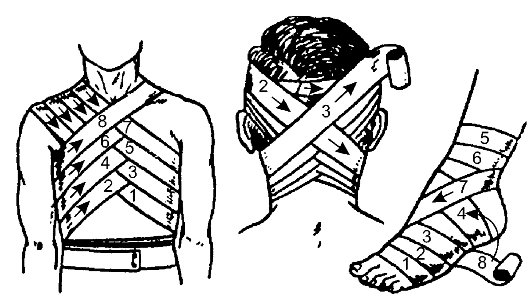
Now let's discuss how to properly bandage your knee with an elastic bandage. By the way, we will also bandage the elbow!
These effects may have pain side effects. The differences between the two bandage sizes have not previously been reported. The lighter bandage improved and tended to improve proprioception, whereas the standard bandage did not. This may mean that the recruitment of cutaneous receptors depends on the pressure applied and the duration of the stimuli. Skin receptors are known to respond strongly to new stimuli, such as the movement of a bandage on the skin, and quickly adapt when the stimuli become monotonous.
Awareness of pressure on the skin, sufficient to create indentations up to 2 mm in size, has been shown to disappear within one to two minutes. Therefore, an important area for future research is to investigate the optimal tension at which elastic bands produce physiological effects. The study has several important points. First, it is unlikely that true blinding was achieved. Although the subjects were not told the size that was used, they were aware that they were wearing a bandage and that the intervention could be beneficial, and may have experienced differences between bandages even for two weeks.
Bandaging the knee and elbow joint with an elastic bandage is the most common procedure in everyday life.
Take a close look at the picture below, this is the so-called “Turtle” bandage for the knee joint:
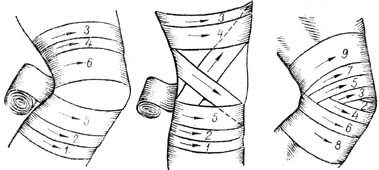
Left and center - we wrap an elastic bandage towards the center, this is a “converging” tortoiseshell bandage.
But on the right we wrap an elastic bandage in “up and down” circles from the center - this is a diverging turtle bandage.
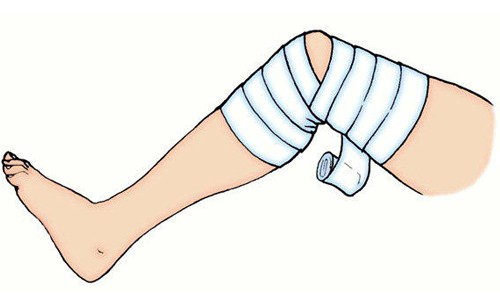
The purpose of such a bandage is to limit the mobility of the knee joint and NOT FALL OFF.
So how do you put an elastic bandage on your knee so that it doesn't fall off?
How to wrap your knee with an elastic bandage
The first thing you should do is ask the patient to bend their knee so that it is as comfortable as possible.
The knee can also be a sprain!
The bandage will need to be wound as evenly as possible to avoid wrinkles.
We place the bandage on top of the knee and fix it with a double turn. We lower it below the knee and fix it again. The intersection is under the knee. The procedure is repeated in reverse order and so on several times.
![]()
You can use an elastic bandage on the elbow joint in the same way.
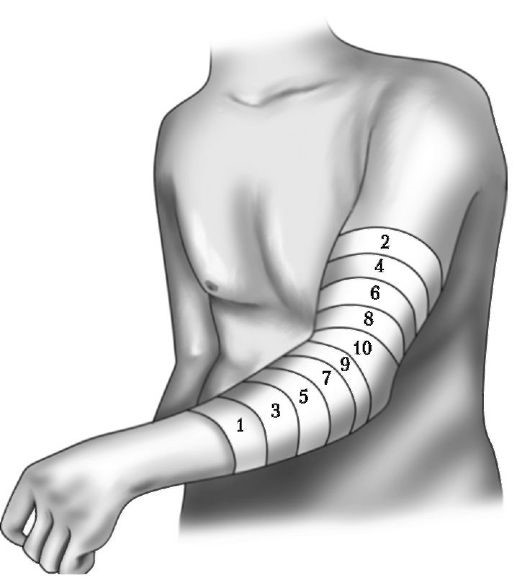
How to properly bandage your foot with an elastic bandage in the heel area
Believe me, it's difficult!
The heel is rounded and the bandage tends to slip off when walking up or down.
The most successful bandage is in the form of a divergent tortoiseshell bandage, but the first securing move is made directly through the heel:
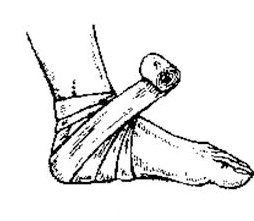
For heel bursitis, a more voluminous bandage is needed:
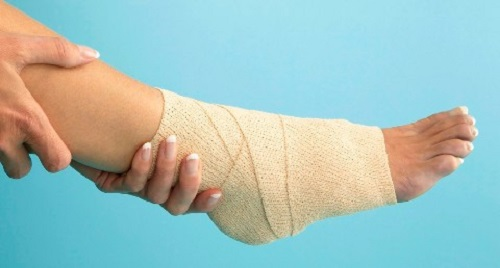
This bandage makes it possible to apply medications and lotions to the heel, and also protects the heel quite well from stress.
How to wrap your leg with an elastic bandage for sprains
Before bandaging a sprained leg, you need to cool it down - to do this, you will have to lie down for half an hour with a cold heating pad, an ice bag, or just a bottle of cold water.
It is strictly forbidden to overheat the sprained area or lubricate it with warming ointments.
The next task is to immobilize the stretched area as much as possible. Bed rest may be prescribed for several days.
When spraining a ligament, you need to bandage the limb from BOTTOM. This will prevent tissue swelling that is inevitable during stretching).
An elastic bandage is attached below the stretched area (let's say these are the toes).
Here, the screw bandaging technique is most suitable, which in the joint area may contain elements of a tortoiseshell bandage.
Even after applying a bandage, apply an ice pack to the sprained area.
It is good to alternate such applications every 15 minutes.
At night, you can loosen the bandage a little.
Modern desmurgy offers a technique for taping sprained ligaments:

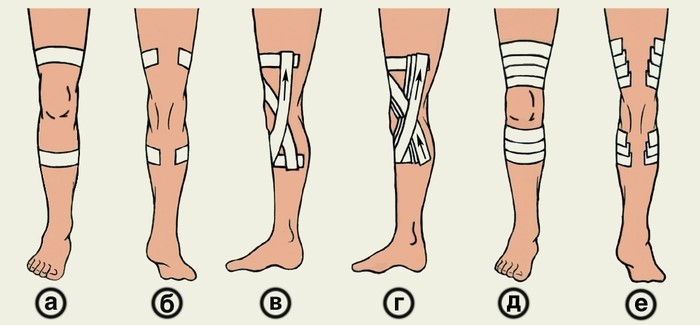
Kinesio tape or elastic tape bandage of low extensibility, adhesive - it is glued in the directions of damaged ligaments or muscles, it is also called an elastic bandage.
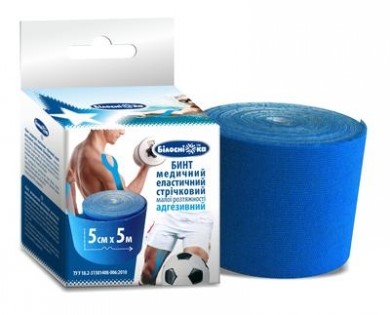
This elastic bandage is literally indispensable during the rehabilitation period after an injury.
If the ligaments or muscles are injured and are unable to stretch, this method of application is used - the kinesio tape is stretched before applying it to the skin. Due to its elasticity, the tape contracts and forms folds on the skin and at the same time supports the injured area.
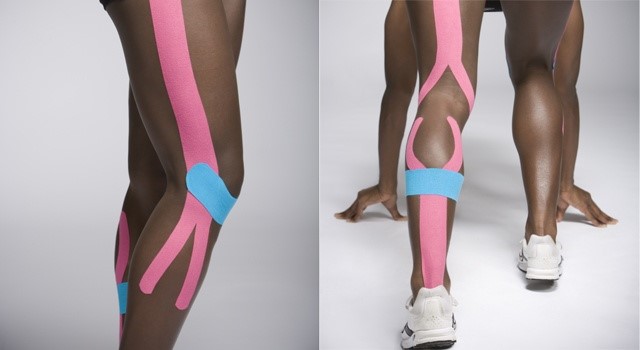
A person easily and quickly performs various movements. When a knee is injured, in order to restore its previous functionality, the victim must undergo a course of treatment, which includes wearing a special bandage for the knee joint. This knee brace helps during rehabilitation activities and also fixes the limb in the desired position. Let's take a closer look at what a knee brace is, what types there are, how to choose and use it correctly.
In what situations does a person need braces?
In some situations, bandages and other types of fixation are required. According to the time specified by the doctor, the patient should wear the bandage in the following situations:
- When stretched and;
- For infectious and inflammatory damage to the joint capsule;
- When the knee pad melts;
- For Schlatter-Osgood disease.
Knee braces are prescribed by a doctor to prevent injury if a person is involved in dangerous sports. To prevent injury, bandages are placed on the knee joint. Also, people who perform heavy physical activity are forced to wear a sports knee brace.
If the knee has already been injured, special fixation is a must. An elastic bandage or bandage will reduce the stress on the knee and the affected area, allowing the injury to heal in a short period of time. Special fixatives will relieve swelling, swelling and reduce pain.
During rehabilitation after surgery on the leg or a fracture, the limb needs to be fixed. Therefore, a therapeutic fixative is used.
To relieve the joint, a special sports knee brace is used. For arthrosis, arthritis, coxarthrosis and other destructive diseases, a rigid fixator is used for treatment, which fixes the limb and prevents the knee from functioning improperly.
What is taping
Knee taping is carried out to speed up rehabilitation, as well as to prevent injuries received during sports activities. Taping is usually done to prevent damage to the meniscus.
Thanks to taping, pain and inflammation in the knee are relieved. Lymph drainage is performed, muscle tone is normalized, the injury heals much faster, weakened muscles are restored faster. It also prevents sprains and tears of ligaments, and increases endurance during exercise.
The tapes used for taping are entirely cotton, stretch well, are breathable, breathable, hold the leg well, and are waterproof. They are an elastic bandage coated on one side with glue.
Tapes should be applied to clean skin. It is important to shave your legs before use. Wrap a special sports bandage around your leg and press it down a little with your hand so that the tapes stick well to the skin.
After taping, you can shower and exercise only after forty-five minutes.
Types of fasteners
To fix the knee joint, there are splints, calipers, braces, knee pads, an elastic bandage and a knee bandage.
Splints
Orthoses are used to rigidly fix the joint. The knee splint is made of soft knitted fabric that fits a metal frame. To ensure that the bandage fits well to the knee, the fabric is additionally diluted with lavsan fibers. This fixative is hypoallergenic. To allow the skin to breathe, the top of the splint is covered with mesh.
 The knee splint has the following types:
The knee splint has the following types:
- A splint that completely immobilizes the knee;
- Orthoses with a medium degree of fixation;
- Hinged splints. This type of fixator is most often used for fractures.
To do right choice splint in a particular case, it is important to consult a doctor.
Calipers
A knee support is a bandage that immobilizes and moderately stabilizes the patella and knee joint. The menisci and collateral ligaments are supported by the caliper. It should be worn by people who lead an active lifestyle, as a result of which they get sprains and dislocations of the knee.
The knee support is worn before sports training, jogging or other sporting events.
- During rehabilitation after knee surgery;
- After injury;
- To prevent joint damage during sports activities;
- When the joint is loose, unstable during walking, bends or pops out;
- When you feel pain due to arthritis, arthrosis, synovitis or bursitis.
A specialist should select the caliper. Therefore, before purchasing it, you need to visit an experienced doctor.
Brace
The knee brace is a neopreon knee pad with reinforced ribs and hinges on the sides. This type of brace is used to immobilize the knee after a fracture or surgery. The brace is recommended to be worn in the following cases:
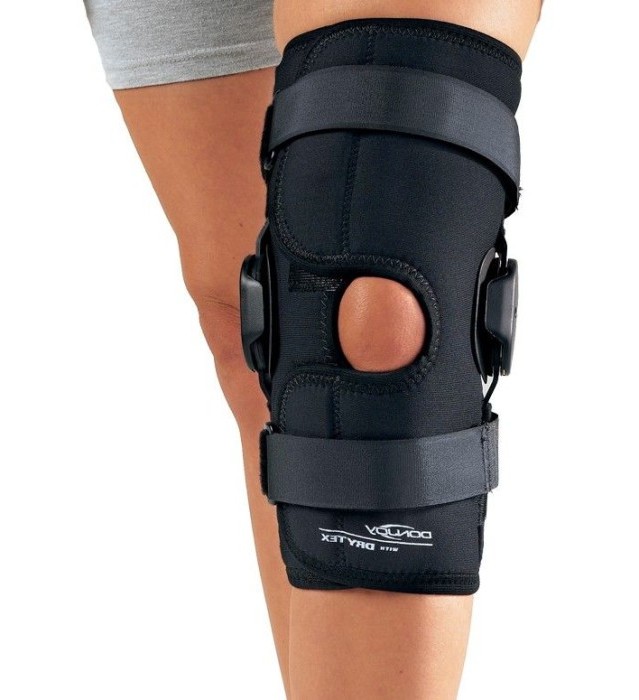
Thanks to the braces, the range of knee flexion is regulated, so the patient can do special physical therapy without loading the joints.
Polycentric locks in the braces allow you to fix the knee in the desired position. For example, at 10, 20, 40, 60, 90 and 150 degrees. In some models, you can independently set the bending angle without using the specified parameters.
Bandages
The brace is a sports knee brace for fixing the knee in the desired position and for supporting it. It can be metal, plastic, ceramic, elastic with special plates. Bandages have different sizes, colors and design.
Types of bandages:
- In order to prevent and prevent damage to the knee, a rigid bandage is used;
- To support and strengthen already damaged joints, a functional rigid bandage is used;
- For the purpose of rehabilitation after surgery and restoration of the joint after injury, a rehabilitation rigid bandage is used;
- To relieve the load on the knee joint and relieve some of the pain due to arthrosis or arthritis, a rigid unloading bandage is used.
To choose the right bandage, it is important to consult a doctor. If a sports or other type of knee brace is not chosen correctly, the leg can be severely deformed. Therefore, after a thorough examination of the patient, the specialist selects the desired size, shape, and degree of rigidity of the retainer.
Elastic bandages
The sports bandage is recommended for use by athletes during sports activities. Especially when squatting with a barbell weighing one hundred kilograms or more. In addition, the bandage is sometimes used for arthrosis and other similar joint diseases in order to relieve pain at least a little.
To bandage the knee joint with an elastic bandage, you must strictly follow the following rules:
- You need to start wrapping the bandage twenty centimeters below the knee with 1-2 turns of the bandage;
- Next, the bandage must be passed obliquely through the popliteal fossa onto the thigh, twenty centimeters above the joint. Make a couple of turns here;
- You need to bandage with oblique and reverse movements;
- At the end, the bandage is fixed in a circular motion around the knee.
It is best to wrap a sports or therapeutic bandage, especially for arthrosis, in the morning. Before wrapping your legs, you need to slightly raise them for fifteen minutes. You need to wrap it, moving from a narrow place to a wide one, evenly distributing the bandage over the surface of the joint so that folds do not form.
To avoid swelling, do not wrap your leg tightly. If you tighten the bandage too much, the patient will feel a strong pulsation and numbness in the toes.
How to care for knee braces
A sports knee pad, elastic bandage, support, splint, brace and other types of braces that are used for injuries and various joint diseases (for example, arthrosis) get dirty very easily and quickly. Therefore, you need to know how to properly care for them.
The elastic bandage is machine washable. They do not deform and do not lose their functions. But it is recommended to dry them on the balcony, and not on the radiator.
More complex structures require careful maintenance. The sports knee pad with medium and high fixation can only be washed by hand. It is better to wipe metal or plastic inserts with a damp cloth so as not to damage their shape and integrity. Drying in the fresh air is also important.
When purchasing such a retainer, it is important to inquire what material it is made of, so that in the future you will know how to care for it. The bandage can be used on the leg without damage. If there are ulcers or rashes, the sports fixative cannot be used.
Attention! Noticed an error in the text? Select it with the mouse and press the keys in sequence Ctrl + Enter. Thank you for your help in developing the site!









